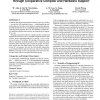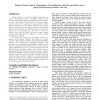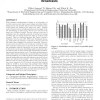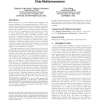MICRO
2009
IEEE
14 years 9 months ago
2009
IEEE
Performance and power are the first order design metrics for Network-on-Chips (NoCs) that have become the de-facto standard in providing scalable communication backbones for mult...
MICRO
2009
IEEE
14 years 9 months ago
2009
IEEE
A platform that supported Sequential Consistency (SC) for all codes — not only the well-synchronized ones — would simplify the task of programmers. Recently, several hardware ...
MICRO
2009
IEEE
14 years 9 months ago
2009
IEEE
The phase-change random access memory (PRAM) technology is fast maturing to production levels. Main advantages of PRAM are non-volatility, byte addressability, in-place programmab...
MICRO
2009
IEEE
14 years 9 months ago
2009
IEEE
Voltage scaling is one of the most effective mechanisms to reduce microprocessor power consumption. However, the increased severity of manufacturing-induced parameter variations a...
MICRO
2009
IEEE
14 years 9 months ago
2009
IEEE
Data structures define how values being computed are stored and accessed within programs. By recognizing what data structures are being used in an application, tools can make app...
MICRO
2009
IEEE
14 years 9 months ago
2009
IEEE
Network-on-Chips (NoCs) are likely to become a critical shared resource in future many-core processors. The challenge is to develop policies and mechanisms that enable multiple ap...
MICRO
2009
IEEE
14 years 9 months ago
2009
IEEE
The increasing power dissipation of current processors and processor cores constrains design options, increases packaging and cooling costs, increases power delivery costs, and de...
MICRO
2009
IEEE
14 years 9 months ago
2009
IEEE
With transistor miniaturization leading to an abundance of on-chip resources and uniprocessor designs providing diminishing returns, the industry has moved beyond single-core micr...
MICRO
2009
IEEE
14 years 9 months ago
2009
IEEE
Hardware support for dynamic analysis can minimize the performance overhead of useful applications such as security checks, debugging, and profiling. To eliminate implementation ...
MICRO
2009
IEEE
14 years 9 months ago
2009
IEEE




